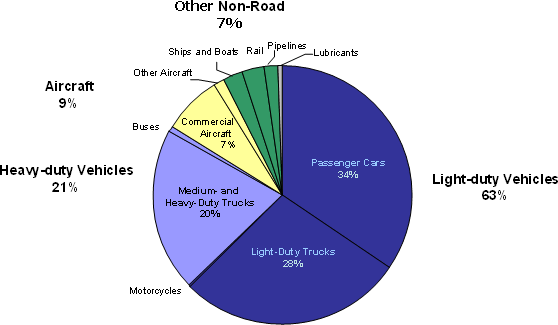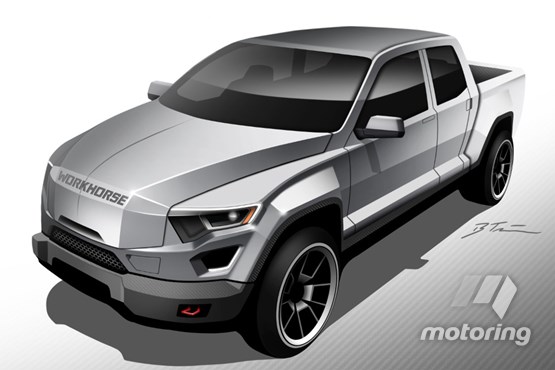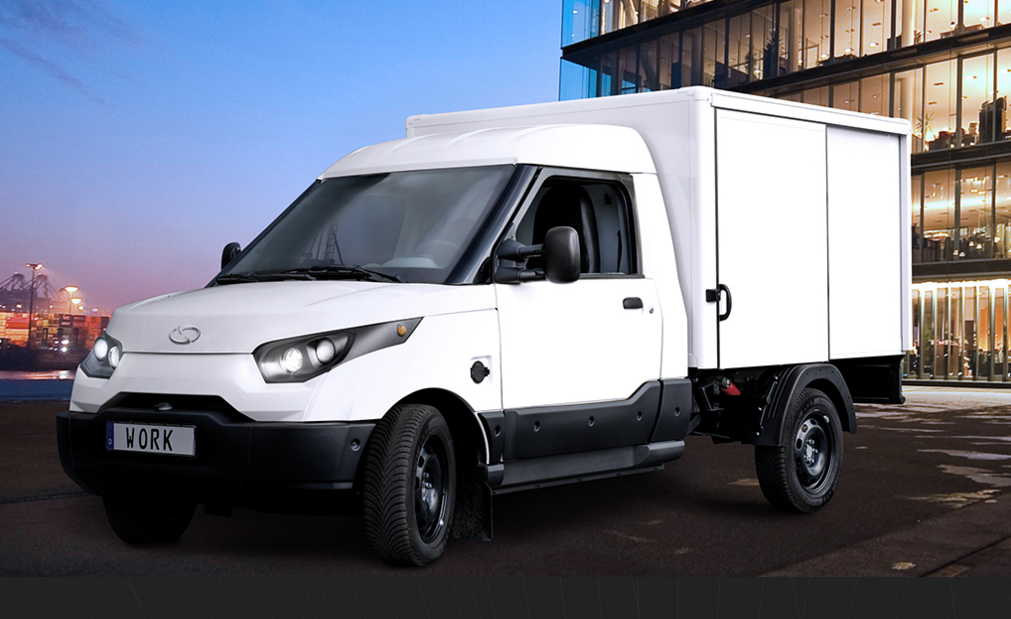News
Electric trucks from large to small vital to Tesla’s Master Plan
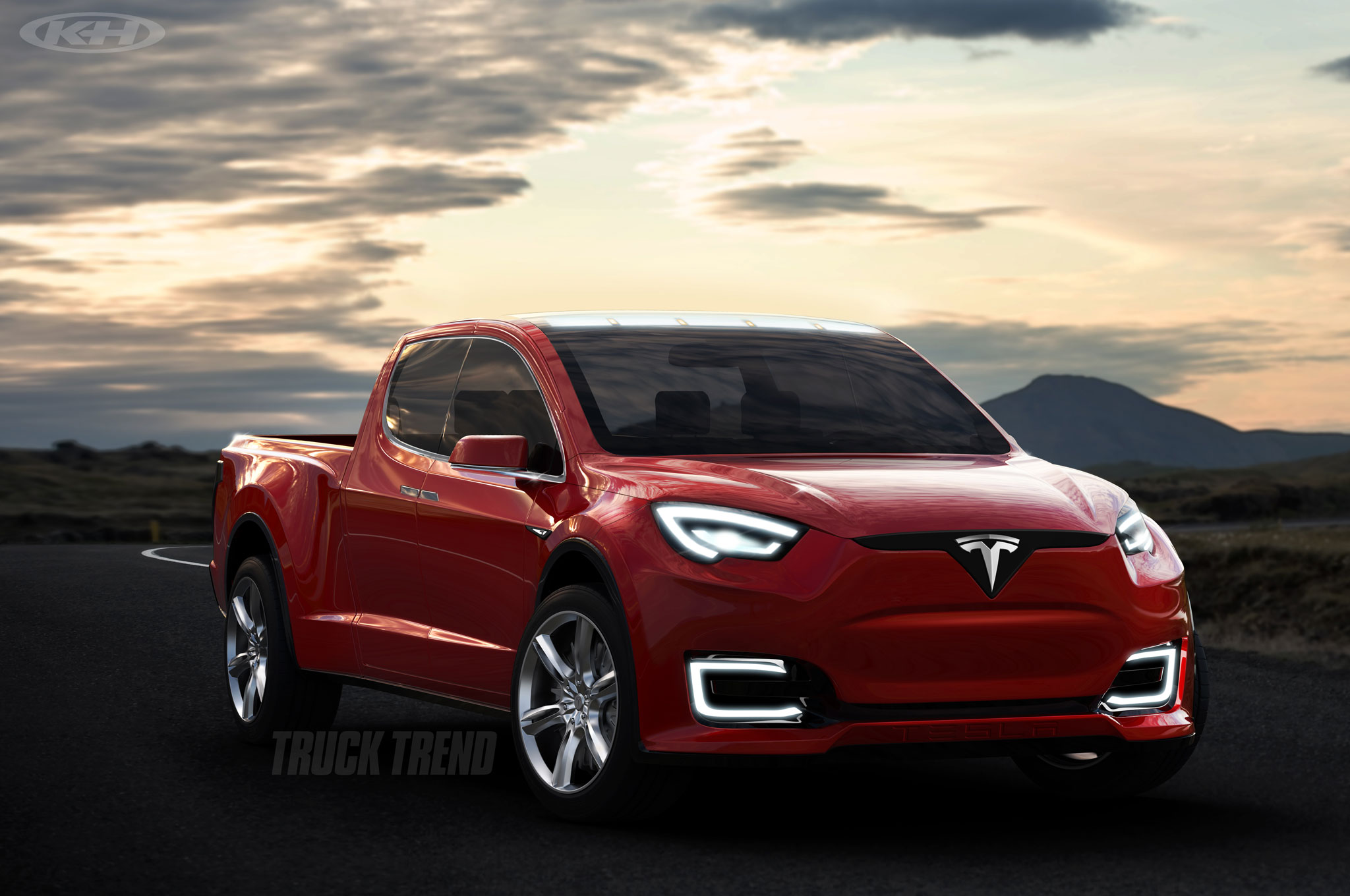
It all goes back to Elon Musk’s original secret Master Plan from 2006, when the billionaire entrepreneur issued his famous vision of the future: “[T]he overarching purpose of Tesla Motors (and the reason I am funding the company) is to help expedite the move from a mine-and-burn hydrocarbon economy towards a solar electric economy, which I believe to be the primary, but not exclusive, sustainable solution.”
Musk made an executive decision right from the beginning to target customers whose opinions influence others by building premium electric cars that would make people sit up and take notice. Until Tesla came along, electric cars were little more than glorified golf carts. But if Tesla is going to make significant progress toward its ultimate goal, it is going to have to make electric trucks as well as passenger cars. Trucks are responsible for about 50% of all emissions created by the transportation sector according to the EPA. It’s no wonder Musk’s follow up plan calls for a zero emissions Tesla targeted at the mid to heavy duty truck segment.
The Tesla Plan
“In addition to consumer vehicles, there are two other types of electric vehicle needed: heavy-duty trucks and high passenger-density urban transport. Both are in the early stages of development at Tesla and should be ready for unveiling next year,” outlines Musk in his Master Plan Part Deux.
Aaron Turpen previously gave us an excellent analysis of what characteristics a Tesla pickup would need to have in order to be successful. He set out in detail what Tesla would need to do to build such a truck.
- V8-like performance including roughly 400 hp and 380 lb-ft
- Extended and four-door cab offerings
- Cargo bed size of 5.5 feet with option for 7 feet
- Towing capacity of about 10,000 pounds
- Payload capacity of 1/2 ton to 3,000 pounds
- 4×4 capability
- Driving range, under load, of at least 150 miles
- Conventional styling and appeal
How is Tesla going to make batteries with the energy and power needed to move such heavy vehicles? The Powerwall may offer clues. Just one year after it was introduced, Tesla brought its second generation version to market with roughly double the capacity of the original. Tesla doesn’t reveal very much about its ongoing battery research programs, other than to say that improvements of between 5 and 7 percent a year are anticipated as it ramps up production at the Gigafactory.
One assumption is that batteries for trucks will be significantly different from those used on its passenger cars, with more focus on energy and less focus on power. While a Tesla pickup that breaks the 3 second 0-60 barrier would be very cool, that sort of acceleration would have little relevance to how a truck gets used in daily driving.
When it comes to trucks that haul freight, it’s possible that the company has some sort of battery swapping plan in mind at truck stops along major transportation routes. Another approach would be to simply swap tractors at designated service areas much the way Formula E drivers swap cars during a race. Tesla could own the trucks and lease them to freight companies. The idea is as old as the Pony Express.
What About The Competition?
While Tesla is busy planning its truck strategy, other companies are chasing the same low emissions dream. Most of them rely on some form of range extender engine to build a truck that has low emissions but is cost competitive. The most promising of those ventures may be from Workhorse, which claims it will have a full size plug-in hybrid pickup truck with dual motors on the market by 2018. It uses the two cylinder range extender engine from the BMW i3 REx to provide electricity to the battery when needed. A rendering of the truck by Australia’s Motoring shows a truck that is purposeful rather than svelte in its design.
Delivery and cargo vans are another target market. Four large cities — Mexico City, Paris, Madrid, and Athens — announced their intention to ban all diesel powered vehicles from their streets by 2025. Many of the medium duty trucks used to deliver food and consumer goods to city dwellers are powered by diesel engines, especially in Europe.
Deutsche Post, known globally as DHL, is one of the largest parcel delivery companies in the world. It is working hard to reduce its carbon footprint but could not find an all electric van suitable for its needs. So it built its own. “We designed it as a tool. So the fit and finish does not need to be as good as in a passenger car,” Win Neidlinger, director of business development at Deutsche Post tells Fortune. “It did not cost billions to develop and produce. You will not believe how cheap it is to make.” The company now plans to become a manufacturer and start selling the vans, which it calls StreetScooters, to customers in 2017.
UPS is also in the delivery business and is a world leader in testing alternative fuels and alternative powertrains in its trucks. It has invested more than $750 million in alternative fuel and advanced technology vehicles since 2009. UPS now has 7,700 low emission vehicles in its “rolling laboratory” test fleet and is evaluating vehicles that run on natural gas, renewable natural gas, and propane according to Electric Cars Report.
It also is using electric powertrains in some of its vehicles. A version of the Workhorse plug-in hybrid range extender system is being tested in several of its delivery vans. It is also thinking small when it comes to what is known in the industry as the “last mile” conundrum. How do companies like UPS create nimble, zero emissions vehicles that can access congested urban areas? One solution being tried in Hamburg, Germany and Portland, Oregon is a hybrid electric tricycle called the eBike. It has a battery and electric motor and can move using pedal power, electric power, or a combination of both.
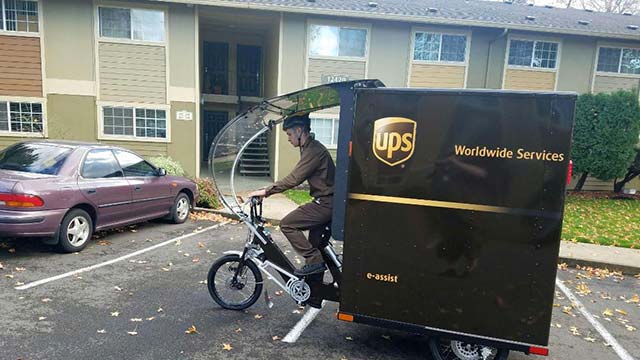
Photo credit: UPS
Some of the biggest polluters are garbage and trash hauling trucks. Because the stop and start hundreds of times a day, their diesel engines are constant spewing toxic pollutants into the atmosphere. While their total numbers are small, they discharge a disproportionate amount of emissions to the atmosphere. Taming the emissions from beasts would be an important step forward.
Ian Wright, a Tesla co-founder and former board member, thinks he has a solution. His company, Wrightspeed, builds heavy trucks powered solely by electricity but with a twist. Wright and his engineering staff have invented a small natural gas powered turbine that acts as a range extender engine. He claims his turbine operates so cleanly, it does not require a catalytic converter to meet California’s strict tailpipe emissions laws.
Salt Lake City start-up Nikola Motors recently revealed its idea for a 1000 HP low emissions electric truck called the Nikola One. Sleek and futuristic, it relies on battery power to turn its six electric motors but also has an onboard hydrogen fuel cell that is says will give the tractor a range of 800 to 1000 miles. The company says it has over a billion dollars worth of reservations in hand. While it did present a full size prototype at the reveal, many are taking a wait and see attitude toward Nikola Motors, which has no factory at the present time but claims it will begin production in 2018.
Summary
Trucks will play an important role in reducing global emissions from the transportation sector. A recent report from Navigant Research predicts annual sales of electric trucks — including hybrids and plug-in hybrids — will increase by a factor of ten over the next decade. From 31,000 worldwide today, Navigant says more than 332,000 electric trucks will be sold annually by 2026. That’s a big market for manufacturers to target.
Tesla has refused to consider any sort of range extender device for its cars, but solving the problems of building low emissions trucks for delivering freight and cargo across long distances may make such things a necessity. The need is great and the time is short. If hybrid trucks are what are needed, even as a stop gap measure while battery technology catches up with energy and cost constraints, that would be important for a world struggling to limit carbon emissions.

Elon Musk
Tesla CEO Elon Musk teases insane capabilities of next major FSD update

Tesla CEO Elon Musk teased the insane capabilities of the next major Full Self-Driving update just hours after the company rolled out version 14.2 to owners.
Tesla Full Self-Driving v14.2 had some major improvements from the previous iteration of v14.1.x. We were on v14.1.7, the most advanced configuration of the v14.1 family, before Tesla transitioned us and others to v14.2.
However, Musk has said that the improvements coming in the next major update, which will be v14.3, will be where “the last big piece of the puzzle finally lands.”
14.3 is where the last big piece of the puzzle finally lands
— Elon Musk (@elonmusk) November 21, 2025
There were some major improvements with v14.2, most notably, Tesla seemed to narrow in on the triggers that caused issues with hesitation and brake stabbing in v14.1.x.
One of the most discussed issues with the past rollout was that of brake stabbing, where the vehicle would contemplate proceeding with a route as traffic was coming from other directions.
We experienced it most frequently at intersections, especially four-way stop signs.
Elon Musk hints at when Tesla can fix this FSD complaint with v14
In our review of it yesterday, it was evident that this issue had been resolved, at least to the extent that we had no issues with it in a 62-minute drive, which you can watch here.
Some owners also reported a more relaxed driver monitoring system, which is something Tesla said it was working on as it hopes to allow drivers to text during operation in the coming months. We did not test this, as laws in Pennsylvania prohibit the use of phones at any time due to the new Paul Miller’s Law, which took effect earlier this year.
However, the improvements indicate that Tesla is certainly headed toward a much more sentient FSD experience, so much so that Musk’s language seems to be more indicative of a more relaxed experience in terms of overall supervision from the driver, especially with v14.3.
Musk did not release or discuss a definitive timeline for the release of v14.3, especially as v14.2 just rolled out to Early Access Program (EAP) members yesterday. However, v14.1 rolled out to Tesla owners just a few weeks ago in late 2025. There is the potential that v14.3 could be part of the coming Holiday Update, or potentially in a release of its own before the New Year.
News
Tesla Full Self-Driving v14.2 – Full Review, the Good and the Bad

Tesla rolled out Full Self-Driving version 14.2 yesterday to members of the Early Access Program (EAP). Expectations were high, and Tesla surely delivered.
With the rollout of Tesla FSD v14.2, there were major benchmarks for improvement from the v14.1 suite, which spanned across seven improvements. Our final experience with v14.1 was with v14.1.7, and to be honest, things were good, but it felt like there were a handful of regressions from previous iterations.
While there were improvements in brake stabbing and hesitation, we did experience a few small interventions related to navigation and just overall performance. It was nothing major; there were no critical takeovers that required any major publicity, as they were more or less subjective things that I was not particularly comfortable with. Other drivers might have been more relaxed.
With v14.2 hitting our cars yesterday, there were a handful of things we truly noticed in terms of improvement, most notably the lack of brake stabbing and hesitation, a major complaint with v14.1.x.
However, in a 62-minute drive that was fully recorded, there were a lot of positives, and only one true complaint, which was something we haven’t had issues with in the past.
The Good
Lack of Brake Stabbing and Hesitation
Perhaps the most notable and publicized issue with v14.1.x was the presence of brake stabbing and hesitation. Arriving at intersections was particularly nerve-racking on the previous version simply because of this. At four-way stops, the car would not be assertive enough to take its turn, especially when other vehicles at the same intersection would inch forward or start to move.
This was a major problem.
However, there were no instances of this yesterday on our lengthy drive. It was much more assertive when arriving at these types of scenarios, but was also more patient when FSD knew it was not the car’s turn to proceed.
Can report on v14.2 today there were ZERO instances of break stabbing or hesitation at intersections today
It was a significant improvement from v14.1.x
— TESLARATI (@Teslarati) November 21, 2025
This improvement was the most noticeable throughout the drive, along with fixes in overall smoothness.
Speed Profiles Seem to Be More Reasonable
There were a handful of FSD v14 users who felt as if the loss of a Max Speed setting was a negative. However, these complaints will, in our opinion, begin to subside, especially as things have seemed to be refined quite nicely with v14.2.
Freeway driving is where this is especially noticeable. If it’s traveling too slow, just switch to a faster profile. If it’s too fast, switch to a slower profile. However, the speeds seem to be much more defined with each Speed Profile, which is something that I really find to be a huge advantage. Previously, you could tell the difference in speeds, but not in driving styles. At times, Standard felt a lot like Hurry. Now, you can clearly tell the difference between the two.
It seems as if Tesla made a goal that drivers should be able to tell which Speed Profile is active if it was not shown on the screen. With v14.1.x, this was not necessarily something that could be done. With v14.2, if someone tested me on which Speed Profile was being used, I’m fairly certain I could pick each one.
Better Overall Operation
I felt, at times, especially with v14.1.7, there were some jerky movements. Nothing that was super alarming, but there were times when things just felt a little more finicky than others.
v14.2 feels much smoother overall, with really great decision-making, lane changes that feel second nature, and a great speed of travel. It was a very comfortable ride.
The Bad
Parking
It feels as if there was a slight regression in parking quality, as both times v14.2 pulled into parking spots, I would have felt compelled to adjust manually if I were staying at my destinations. For the sake of testing, at my first destination, I arrived, allowed the car to park, and then left. At the tail-end of testing, I walked inside the store that FSD v14.2 drove me to, so I had to adjust the parking manually.
This was pretty disappointing. Apart from parking at Superchargers, which is always flawless, parking performance is something that needs some attention. The release notes for v14.2. state that parking spot selection and parking quality will improve with future versions.
Any issues with parking on your end? 14.1.7 didn’t have this trouble with parking pic.twitter.com/JPLRO2obUj
— TESLARATI (@Teslarati) November 21, 2025
However, this was truly my only complaint about v14.2.
You can check out our full 62-minute ride-along below:
Elon Musk
SpaceX issues statement on Starship V3 Booster 18 anomaly
The incident unfolded during gas-system pressure testing at the company’s Massey facility in Starbase, Texas.

SpaceX has issued an initial statement about Starship Booster 18’s anomaly early Friday. The incident unfolded during gas-system pressure testing at the company’s Massey facility in Starbase, Texas.
SpaceX’s initial comment
As per SpaceX in a post on its official account on social media platform X, Booster 18 was undergoing gas system pressure tests when the anomaly happened. Despite the nature of the incident, the company emphasized that no propellant was loaded, no engines were installed, and personnel were kept at a safe distance from the booster, resulting in zero injuries.
“Booster 18 suffered an anomaly during gas system pressure testing that we were conducting in advance of structural proof testing. No propellant was on the vehicle, and engines were not yet installed. The teams need time to investigate before we are confident of the cause. No one was injured as we maintain a safe distance for personnel during this type of testing. The site remains clear and we are working plans to safely reenter the site,” SpaceX wrote in its post on X.
Incident and aftermath
Livestream footage from LabPadre showed Booster 18’s lower half crumpling around the liquid oxygen tank area at approximately 4:04 a.m. CT. Subsequent images posted by on-site observers revealed extensive deformation across the booster’s lower structure. Needless to say, spaceflight observers have noted that Booster 18 would likely be a complete loss due to its anomaly.
Booster 18 had rolled out only a day earlier and was one of the first vehicles in the Starship V3 program. The V3 series incorporates structural reinforcements and reliability upgrades intended to prepare Starship for rapid-reuse testing and eventual tower-catch operations. Elon Musk has been optimistic about Starship V3, previously noting on X that the spacecraft might be able to complete initial missions to Mars.
